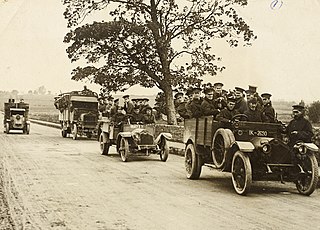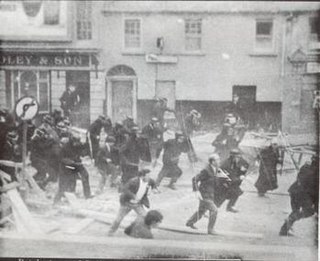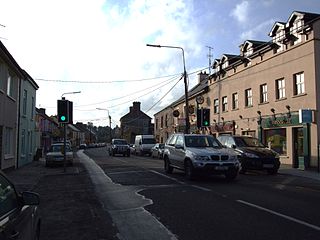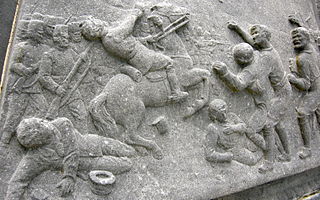In the broader context of racism in the United States, mass racial violence in the United States consists of ethnic conflicts and race riots, along with such events as:

The Royal Irish Constabulary was the police force in Ireland from 1822 until 1922, when all of the island was part of the United Kingdom. A separate civic police force, the unarmed Dublin Metropolitan Police (DMP), patrolled the capital and parts of County Wicklow, while the cities of Derry and Belfast, originally with their own police forces, later had special divisions within the RIC. For most of its history, the ethnic and religious makeup of the RIC broadly matched that of the Irish population, although Anglo-Irish Protestants were overrepresented among its senior officers.

Clonmany is a village and civil parish in north-west Inishowen, in County Donegal, Ireland. The Urris valley to the west of Clonmany village was the last outpost of the Irish language in Inishowen. In the 19th century, the area was an important location for poitín distillation. Outside the village, there are a number of notable townlands, including Kinnea (Rockstown), Crossconnell, Dunaff, and Leenan.

The Swing Riots were a widespread uprising in 1830 by agricultural workers in southern and eastern England in protest of agricultural mechanisation and harsh working conditions. The riots began with the destruction of threshing machines in the Elham Valley area of East Kent in the summer of 1830 and by early December had spread through the whole of southern England and East Anglia. It was to be the largest movement of social unrest in 19th-century England.
The Whiteboys were a secret Irish agrarian organisation in 18th-century Ireland which defended tenant-farmer land-rights for subsistence farming. Their name derives from the white smocks that members wore in their nighttime raids. Because they levelled fences at night, they were usually called "Levellers" by the authorities, and by themselves "Queen Sive Oultagh's children", "fairies", or followers of "Johanna Meskill" or "Sheila Meskill". They sought to address rack-rents, tithe-collection, excessive priests' dues, evictions, and other oppressive acts. As a result, they targeted landlords and tithe collectors. Over time, Whiteboyism became a general term for rural violence connected to secret societies. Because of this generalization, the historical record of the Whiteboys as a specific organisation is unclear. Three major outbreaks of Whiteboyism occurred: in 1761–1764, 1770–1776, and 1784–1786.

The Tithe War was a campaign of mainly nonviolent civil disobedience, punctuated by sporadic violent episodes, in Ireland between 1830 and 1836 in reaction to the enforcement of tithes on the Roman Catholic majority for the upkeep of the established state church, the Church of Ireland. Tithes were payable in cash or kind and payment was compulsory, irrespective of an individual's religious adherence.

Owslebury is a village and civil parish in the county of Hampshire, in the south of England approximately 5 miles (8.0 km) southeast of Winchester. It lies within the administrative district of the City of Winchester.
Events from the year 1834 in the United Kingdom. Uniquely, four Prime Ministers serve during the year.

This is a timeline of the Irish War of Independence of 1919–21. The Irish War of Independence was a guerrilla conflict and most of the fighting was conducted on a small scale by the standards of conventional warfare.

During 12–16 August 1969, there was an outbreak of political and sectarian violence throughout Northern Ireland, which is often seen as the beginning of the thirty-year conflict known as the Troubles. There had been sporadic violence throughout the year arising out of the Northern Ireland civil rights campaign, which demanded an end to discrimination against Catholics and Irish nationalists. Civil rights marches had been attacked by Protestant loyalists, and protesters often clashed with the Royal Ulster Constabulary (RUC), the overwhelmingly Protestant police force.
Events from the year 1834 in Ireland.

Rathcormac is a small town in north County Cork, Ireland. Previously situated on the main Cork to Dublin road, it was bypassed in 2006 by the M8. The former N8 through the town's main street is now the R639 regional road. Rathcormac is located in the Blackwater Valley region and is part of the Cork East Dáil constituency.
The Detroit race riot of 1863 occurred on March 6, 1863, in the city of Detroit, Michigan, during the American Civil War. At the time, the Detroit Free Press reported these events as "the bloodiest day that ever dawned upon Detroit." It began due to unrest among the working class related to racism and the military draft, which was heightened after the Emancipation Proclamation was issued by President Abraham Lincoln. Based in a free state, some recent immigrants and other workers resented being drafted for a war that they thought was waged for the benefit of slaves in the Southern United States, and they feared competition from Black people.
The Ballymurphy massacre was a series of incidents between 9 and 11 August 1971, in which the 1st Battalion, Parachute Regiment of the British Army killed eleven civilians in Ballymurphy, Belfast, Northern Ireland, as part of Operation Demetrius. The shootings were later referred to as Belfast's Bloody Sunday, a reference to the killing of civilians by the same battalion in Derry a few months later, known as Bloody Sunday. The 1972 inquests had returned an open verdict on all of the killings, but a 2021 coroner's report found that all those killed had been innocent and that the killings were "without justification".
The Springhill massacre was an incident in which five Catholic residents were killed by the British Army in the Springhill estate in West Belfast, Northern Ireland, on 9 July 1972, during the Troubles. Three of the victims were teenagers, including a 13-year-old girl, and another was a Catholic priest waving a white flag as he went to attend one of the injured.

The Carrickshock incident, Carrickshock massacre, or battle of Carrickshock was a confrontation between the Irish Constabulary and local Catholic tenant farmers near Carrickshock, near Hugginstown, County Kilkenny, on 14 December 1831, during the Tithe War in Ireland. Seventeen were killed: fourteen of a party attempting to collect tithes and three of the crowd of locals who confronted them. The incident was unusual among massacres in the Tithe War in that the majority of casualties were supporters rather than opponents of tithes.

The Westminster Massacre was an incident that occurred on March 13, 1775, in the town of Westminster, Vermont, then part of the New Hampshire Grants, whose control was disputed between its residents and the Province of New York. It resulted in the killings of two men, William French and Daniel Houghton, by a sheriff's posse, after a crowd occupied the Westminster Courthouse to protest the evictions of several poor farmers from their homes by judges and other officials from New York. The Westminster Massacre is regarded by some Vermont historians as a key event in the history of Vermont.

On 21 March 1985, on the 25th anniversary of the Sharpeville massacre, members of the South African Police opened fire on a crowd of people gathered on Maduna Road between Uitenhage and Langa township in the Eastern Cape, South Africa. The crowd had been attending a funeral of one of the six who had been slain by the apartheid police on 17 March 1985. They had gathered at Maduna Square and were heading towards the house where the funeral was held when the police blocked the road with two armoured vehicles and ordered the crowd to disperse. When the crowd failed to comply immediately, police opened fire on the crowd, killing 35 people and leaving 27 wounded. The incident became known as the Uitenhage/Langa massacre.
Gortroe is a civil parish in the historical barony of Barrymore in County Cork, Ireland. In 1834, during the Tithe War, the Gortroe massacre took place in the area. The village of Bartlemy is within Gortroe civil parish.
William Ryder was Archdeacon of Cloyne from 1834 until his death.











